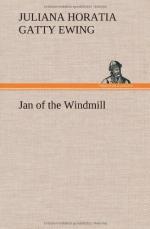It was no very wonderful wood either, this one where he first herded pigs and studied trees. It was composed chiefly of oaks and beeches, none of them of very grand proportions. But it was little cut and little trodden. The bramble-bowers were unbroken, the leaf-mould was deep and rich, and a very tiny stream, which trickled out of sight, kept mosses ever green about its bed. The whole wood was fragrant with honeysuckle, which pushed its way everywhere, and gay with other wild flowers. But the trees were Jan’s delight. He would lie on his back and gaze up into them with unwearying pleasure. He looked at his old etching with new interest, to see how the artist had done the branches of the willows by the water-mill. And then he would get Abel to put a very sharp point to his own slate-pencil, and would go back to the real oaks and beeches, which were so difficult and yet so fascinating to him.
He was very happy in the wood, with two drawbacks. The pigs would stray when he became absorbed in his sketching, and the slate and slate-pencil, which did very well to draw pigs in outline, were miserable implements, when more than half the beauty of the subject to be represented was in its color. For the first evil there was no remedy but to give chase. Out of the second came an amusement in favor of which even the beloved slate hung idle.
In watching beautiful bits of coloring in the wood, contrasted greens of many hues, some jutting branch with yellowish foliage caught by the sun, and relieved by a distance of blue grays beyond,- -colors and contrasts which only grew lovelier as the heavy green of midsummer was broken by the inroad of autumnal tints,—Jan noticed also that among the fallen leaves at his feet there were some of nearly every color in the foliage above. At first it was by a sort of idle trick that he matched one against the other, as a lady sorts silks for her embroidery; then he arranged bits of the leaves upon the outline on his slate, and then, the slate being too small, he amused himself by grouping the leaves upon the path in front of him into woodland scenes. The idea had been partly suggested to him by a bottle which stood on Mrs. Salter’s mantelpiece, containing colored sands arranged into landscapes; a work of art sent by Mrs. Salter’s sister from the Isle of Wight.
The slate would have been quite unused, but for the difficulties Jan got into with his outlines. At last he adopted the plan of making a sketch upon his slate, which he then laid beside him on the walk, and copied it in leaves. More perishable even than the pig-drawings, the evening breeze generally cast these paintings to the winds, but none the less was Jan happy with them, and sometimes in quiet weather, or a sheltered nook, they remained undisturbed for days.
Dame Datchett’s school reopened, but Jan would not leave his pigs. He took the shilling faithfully home each week to his foster-mother. She found it very useful, and she had no very high ideas about education. She had some twinges of conscience in the matter, but she had no strength of purpose, and Jan went his own way.




